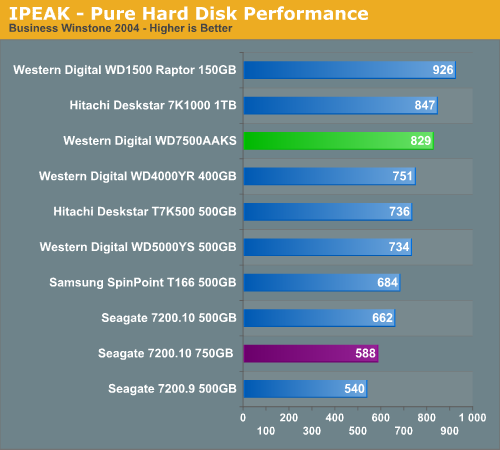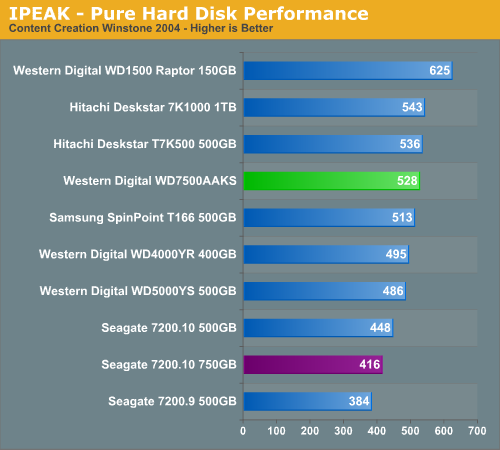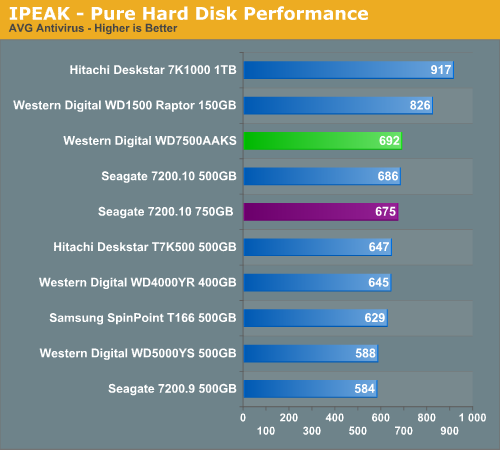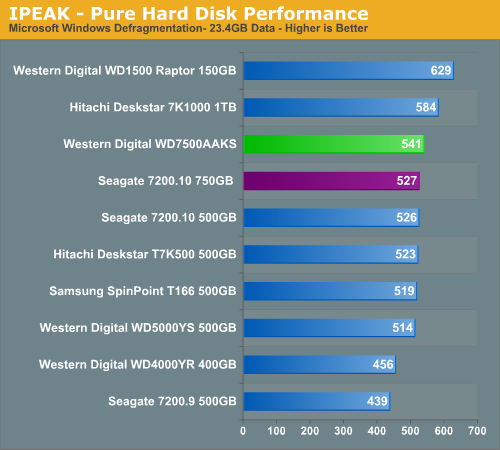Western Digital SE16 750GB: "Quiet" a Performer
by Dave Robinet on August 9, 2007 2:00 AM EST- Posted in
- Storage
iPEAK Business Application Tests
Our iPEAK Winstone benchmarks offer a glimpse into how well our hard disk drives will handle general office applications, media encoding, and graphics manipulation. While the business applications that are being tested tend to be more CPU bound, the performance of the hard drive can and will make a difference in the more disk intensive video and graphics applications where large media files are typically being edited.


As expected, the Raptor drive continues its dominance in our benchmarks, but the WD7500AAKS turns in a very solid showing. Its Business Winstone score of 829 is slightly slower than the Hitachi 7K1000, but significantly faster than the Seagate 7200.10 750GB drive or any of the other 500GB drives we've tested.
iPEAK General Task Tests
The iPEAK based General Task benchmarks are designed to replicate utility based applications that typically are disk intensive and represent common programs utilized on the majority of personal computers. While the WinRAR program is very CPU intensive it will typically stress the storage system in short bursts. Our antivirus benchmark will stress the storage system with continual reads and sporadic write requests while the defragmentation process is split between continual read and write requests.



The WD 750GB performs consistently in third place in our benchmarks, producing results which are behind only the WD Raptor drive (hardly a fair comparison) and the other performance king, the Hitachi 7K1000. The only other 750GB drive tested (the Seagate 7200.10) is bested consistently by the WD7500AAKS.
Note that the WD7500AAKS does fall behind in the AVG Antivirus testing portion of this suite, coming in at a level close to the 7200.10 drive from Seagate. This is a significant improvement over previous WD SE series drives and indicates Western Digital has finely tuned their firmware for small block sizes of data in sequential order.
Our iPEAK Winstone benchmarks offer a glimpse into how well our hard disk drives will handle general office applications, media encoding, and graphics manipulation. While the business applications that are being tested tend to be more CPU bound, the performance of the hard drive can and will make a difference in the more disk intensive video and graphics applications where large media files are typically being edited.


As expected, the Raptor drive continues its dominance in our benchmarks, but the WD7500AAKS turns in a very solid showing. Its Business Winstone score of 829 is slightly slower than the Hitachi 7K1000, but significantly faster than the Seagate 7200.10 750GB drive or any of the other 500GB drives we've tested.
iPEAK General Task Tests
The iPEAK based General Task benchmarks are designed to replicate utility based applications that typically are disk intensive and represent common programs utilized on the majority of personal computers. While the WinRAR program is very CPU intensive it will typically stress the storage system in short bursts. Our antivirus benchmark will stress the storage system with continual reads and sporadic write requests while the defragmentation process is split between continual read and write requests.



The WD 750GB performs consistently in third place in our benchmarks, producing results which are behind only the WD Raptor drive (hardly a fair comparison) and the other performance king, the Hitachi 7K1000. The only other 750GB drive tested (the Seagate 7200.10) is bested consistently by the WD7500AAKS.
Note that the WD7500AAKS does fall behind in the AVG Antivirus testing portion of this suite, coming in at a level close to the 7200.10 drive from Seagate. This is a significant improvement over previous WD SE series drives and indicates Western Digital has finely tuned their firmware for small block sizes of data in sequential order.










37 Comments
View All Comments
retrospooty - Thursday, August 9, 2007 - link
"There seems very little reason to even consider a Raptor anymore. "Except for hte fact that the Raptor 150 is 1 1/2 years old (thats older than the 7200.10 you mentioned) and a 300g Raptor, hopefully with 32m cache is also right around the corner. A300g Raptor with 32m cache will once again own the retail sector by a wide margin.
mostlyprudent - Thursday, August 9, 2007 - link
It will be interesting to see what new Raptor with 32MB of cache can do. I am still skeptical whether it will be able to manage the kind of performance advantage the Raptors had when they were first introduced. I personally think WD will have a tough time charging a significant price premium over other 300GB drives, let alone 750GB and 1TB drives.yyrkoon - Monday, August 13, 2007 - link
You mean the 'whopping' 58MB/s average ? The raptors when first released had issues. Less so now, and they perform much better. Not good enough to justify the cost in my opinion, but whatever floats your boat . . .
ceefka - Friday, August 10, 2007 - link
The Raptor would need more than 32MB cache to get (far) ahead of the pack again, like it did when it was first introduced. Three things they can do:1. Higher density platter :perpendicular
2. 15K rpm? I don't even know if that is possible, but it would be cool.
3. Like you said: 32MB or even more cache.
Martimus - Wednesday, August 15, 2007 - link
The higher density would slow it down, because the heads would need to be more precise. I think that is why the raptors always have less capacity than their caviar brand.retrospooty - Friday, August 10, 2007 - link
Right now the Raptor 150 is ahead of the pack with 16m cache vs 32, and a much lower density per platter, and no perpendicular storage. Add those 3 things and we might be cooking. I have heard rumors that 15k is in the works, but not confirmed.Basilisk - Thursday, August 9, 2007 - link
Or, you may need something loud enough to drown-out your partner's snoring. :)yyrkoon - Monday, August 13, 2007 - link
Funny that, I own a 750GB Seagate, the computer sits less than 4 feet from my head when I sleep up on a desk, and I cannot hear it. Now, If it were not the end of summer, and I were not living in the desert, had all my fans off, I MAY hear the occational disk chatter, but I'll be dahmed if it would ever keep me awake . . .Sometimes I wonder about some of you guys . . .
retrospooty - Thursday, August 9, 2007 - link
??? I dunno. I see AT's comparison always has the Raptor being loud, but I hafve had 1 36g 2 75g and 2 150g Raptors, none of them have been noisy at all, not even compared to other drives. Was I just lucky or is AT's samples unlucky?semo - Thursday, August 9, 2007 - link
is there a difference between the serial ata and the pata se16 wd drives?